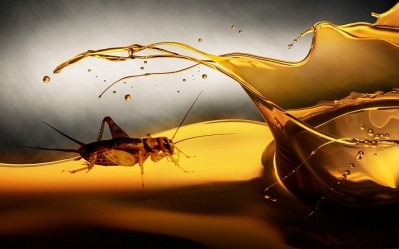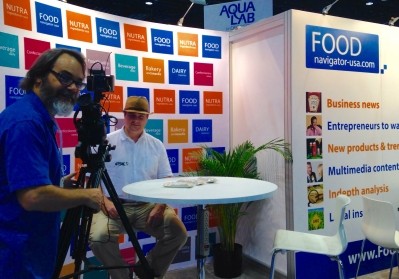Lights, camera, action! Edible insects in focus at IFT 2015
This content item was originally published on www.bakeryandsnacks.com, a William Reed online publication.
We spoke to four experts to get a sense of what insects are like to cook with, getting past the yuck factor, allergen issues, and what needs to change for cricket powder to move from a novelty to a mass market food ingredient…
COOKING WITH BUGS: Chef Michael McGreal, dept chair of culinary arts, Joliet Junior College:
“They are kind of like a blank canvas, at least some of them. With cricket flour, it’s a fairly neutral ingredient, so whatever you are cooking, it kind of absorbs the flavor of it, so it’s really like adding nutrients without really adding flavor, texture or color, so it’s a pretty neat component.
“Meal worms are a little different, they are more like ground chicken or turkey, they have a little bit more flavor, but if you cut them in equal parts with some other meats, that works well, and we’ve used them to make hamburger patties and sliders.
“When I first introduced [insect ingredients] into the classroom, the students looked at them with that look of 'I hope you don’t expect us to try these', but then we talked about the fact that many foods we use come from a body part of an animal… and once they got past that, and understand that it's just another possible food source, we made foods, they tried it, and that they actually thought they tasted pretty good, and the fact that they were getting more nutrients, they thought that was a pretty neat thing too.”
ALLERGIES: Dr Phil Johnson, assistant professor, University of Nebraska-Lincoln:
“The primary issue at the moment is that shellfish allergics appear to be also sensitive to insect protein, there seems to be a cross reaction, but we don’t know enough about it to give solid advice to producers.
“So at the moment all we can suggest is that people that make foods containing insect protein should label them appropriately as being not suitable for shellfish allergics.”
BUG-EATING TRADITIONS: Dr Julie Lesnik, assistant professor, anthropology, Wayne State University:
“Insects have been an important part of the human diet for millions of years... they would have been a very nutritional resource that our hominid ancestors would have utilized a lot…
“We think of insects here in the United States as an ‘alternative’ protein, when really they are a primary food source for billions of people around the world today.”
MASS PRODUCTION: Dr Aaron Dossey, founder & CEO, All Things Bugs:
“As soon as production is mechanized they’ll be very cheap … insects are a very secure source of food/protein, their growth rates are high, they are very prolific, they produce a lot of protein very quickly and efficiently, they are easy to process and they work well in pasta, baked goods, protein shakes and just about any kind of food product…”
Snacks, snack bars and protein powders are the top application areas of interest for edible insect right now. However, cricket powder also works well in burgers, sausages, fruit rollups, shakes and other products. Inclusion rates vary by product, and are in many cases limited by cost rather than functionality, said Laurie Keeler senior manager, product development, at the University of Nebraska, Lincoln.
However, cricket powder is more like a protein powder than wheat flour, said Dr Dossey from All Things Bugs, who is trying to wean people away from using the term 'cricket flour' (click HERE).
"You can’t just do a 1:1 substitution for wheat flour and expect the recipe to turn out the same; you might replace maybe a quarter or a third of wheat flour, but more than that and you’ll run into issues, as wheat flour is mostly starch and cricket powder is mostly protein [67%+] and oil."
While many firms roast and then grind crickets to make a dark, coarser powder, All Things Bugs grinds its insects before heat-treating them, creating a paler, finer powder with a more neutral flavor and smaller particle size (less than 100 microns) with a shelf-life of at least 12 months.
Having trouble watching the video? Try watching it on YouTube instead.
Edible insects will be on the menu at Food Vision USA in October, where delegates will hear from Tiny Farms co-founder Daniel Imrie-Situnayake. Click HERE for full details...




























